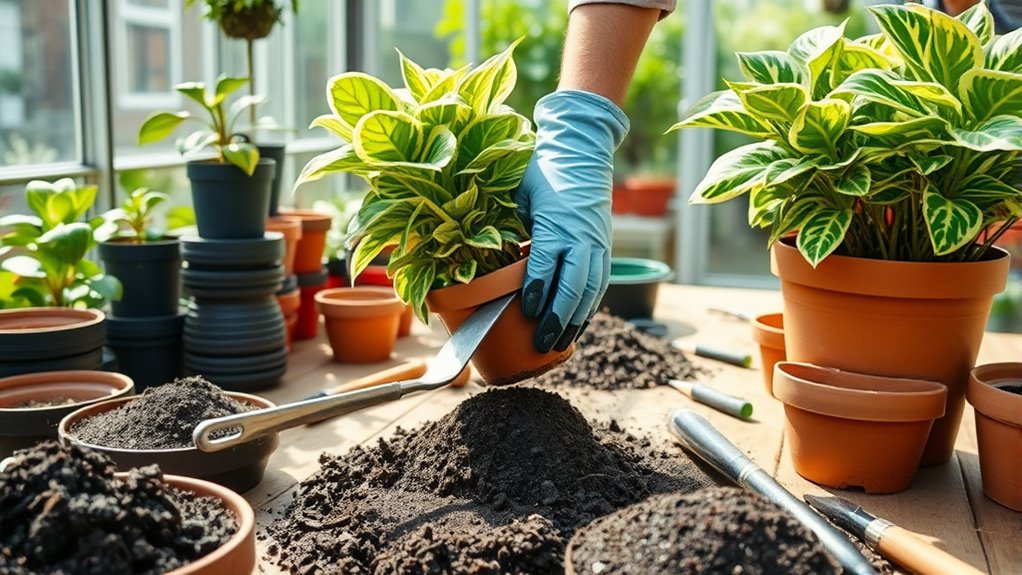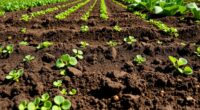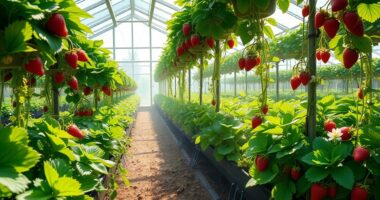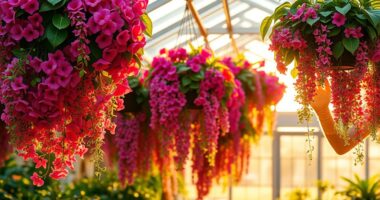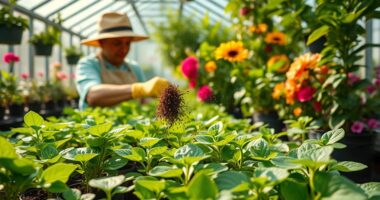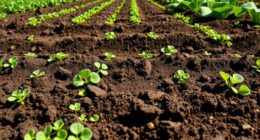To guarantee healthy greenhouse containers, pick the right timing—repot when plants outgrow their pots or show signs like slowed growth or circling roots. Use a well-draining soil mix tailored to your plants, and gently loosen roots before placing them in a slightly deeper pot. Water thoroughly after repotting and monitor moisture to avoid overwatering. Consistent care, from soil choice to watering routines, helps your plants thrive—keep exploring for detailed tips to perfect your repotting skills.
Key Takeaways
- Repot plants when they show signs of slowed growth, circling roots, or water pooling, avoiding extreme weather periods.
- Use well-draining soil mixes like peat moss, perlite, and compost to ensure proper drainage and aeration.
- Gently remove the plant, loosen roots, and position it slightly below the container rim before filling with soil.
- Water thoroughly after repotting and adjust watering schedules based on plant needs and soil moisture.
- Regularly monitor plant response and environment to fine-tune watering and care practices for healthy greenhouse containers.
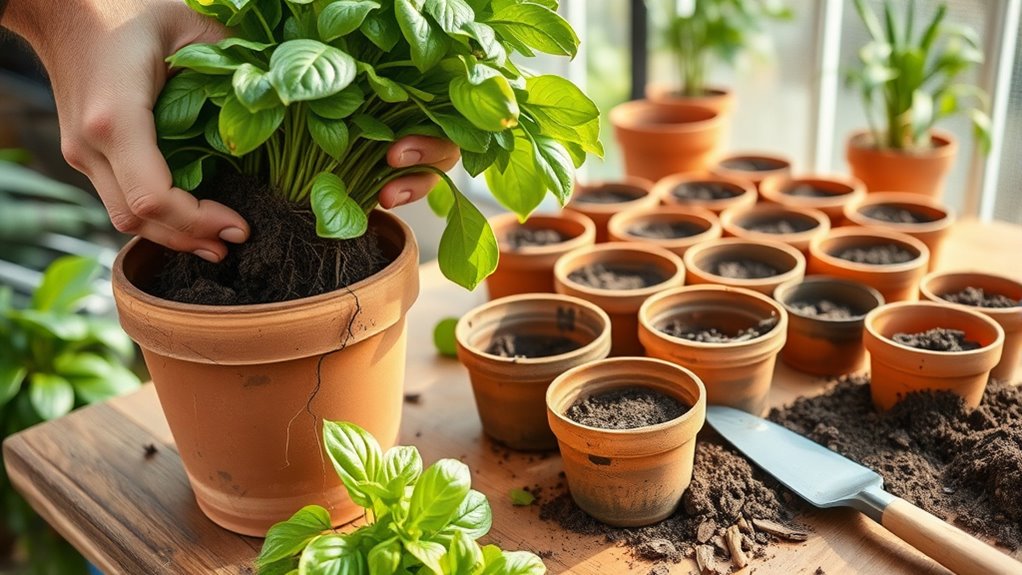
Have you ever wondered when and how to properly pot or repot your plants? Knowing the right timing is vital, but equally important is understanding the best practices to guarantee your plants thrive. When repotting, start by carefully choosing the right soil mixture. A good soil mixture provides proper drainage, aeration, and nutrients, tailored to the specific needs of your plant. For most houseplants, a blend of peat moss, perlite, and compost works well, but some plants might require more specialized soil. Avoid using garden soil directly in containers, as it can become compacted and hinder root growth. To determine if it’s time to repot, look for signs like slowed growth, roots circling the pot’s surface, or water sitting on the surface without soaking in. These signs indicate your plant has outgrown its current container and needs more space.
Once you’ve decided to repot, gently remove the plant from its current container, being careful not to damage the roots. Loosen any tangled or circling roots with your fingers or a gentle tool, which encourages better root growth in the new container. When adding the new soil mixture, fill the bottom of the pot partially, then position the plant so that the top of its root ball is about an inch below the rim of the container. Fill around the roots with fresh soil, pressing lightly to eliminate air pockets. Be sure to leave enough space at the top for watering without overflow. Using a well-draining soil mixture can help prevent overwatering issues and promote healthy root development.
After repotting, establishing a proper watering schedule is essential. Water thoroughly immediately after repotting to settle the soil and hydrate the roots. Moving forward, monitor your plant’s needs carefully. Most plants prefer their soil to dry slightly between waterings, but this varies depending on the species and environment. Overwatering can lead to root rot, so it’s better to err on the side of less water if you’re unsure. Check the top inch of soil regularly; if it feels dry, it’s time to water again. Consistency in watering helps your plant adjust to its new container and promotes healthy growth. Remember, each plant has unique requirements, so observe how your plant responds and adjust your watering schedule accordingly. Proper potting and repotting practices, combined with a tailored watering routine, are key to keeping your greenhouse containers healthy and vibrant.
Frequently Asked Questions
How Often Should I Repot My Greenhouse Plants?
You should repot your greenhouse plants when they become root bound, usually every one to two years. Check if roots are circling the pot’s edge, indicating the plant needs more space. Repotting enhances soil drainage, preventing waterlogged roots and promoting healthy growth. Regularly inspecting your plants ensures they stay healthy and vibrant, and timely repotting helps avoid stress and encourages strong development.
What Are Signs My Plant Needs a Bigger Container?
If your plant shows root bound signs, like roots circling the container’s surface or emerging from drainage holes, it’s time for a bigger pot. Slow growth, yellowing leaves, or water runoff quickly absorbed also indicate root growth needs more space. These are clear root growth indicators that your plant needs a larger container to thrive. Don’t wait too long, or it may struggle to develop properly.
Can I Reuse Old Potting Soil Safely?
You can reuse old potting soil, but you should sterilize it first to kill pests and diseases. Spread the soil out and bake it in the oven at 180°F for about 30 minutes. After sterilization, replenish nutrients by mixing in fresh compost or fertilizer. This process guarantees your soil is safe and provides the necessary nutrients for healthy plant growth, making reuse both practical and sustainable.
What’s the Best Type of Soil for Different Plants?
Imagine planting tomatoes in rich, well-draining soil; they thrive with the right soil amendments like compost and peat moss. You should pick soil types based on plant needs, considering watering frequency to prevent overwatering or dehydration. For example, succulents need sandy, fast-draining soil, while ferns prefer moisture-retentive mixes. Tailoring your soil choice helps your plants grow healthy and strong, ensuring peak growth and minimizing pests.
How Do I Prevent Transplant Shock During Repotting?
To prevent transplant shock during repotting, you should minimize root disturbance by handling the plant gently and keeping roots moist. Avoid soil compaction around the root zone, which can hinder growth. Carefully loosen the root ball and choose the right pot size to reduce stress. By being gentle and maintaining proper soil conditions, you help your plant adjust smoothly and promote healthy growth after repotting.
Conclusion
By following these potting and repotting tips, you’ll guarantee your greenhouse containers stay healthy and vibrant. Did you know that plants in well-maintained containers can grow up to 30% faster? Regularly checking and repotting your plants not only boosts their growth but also prolongs their lifespan. So, stay attentive to your plants’ needs, and you’ll enjoy a lush, thriving greenhouse all year round. Happy gardening!
